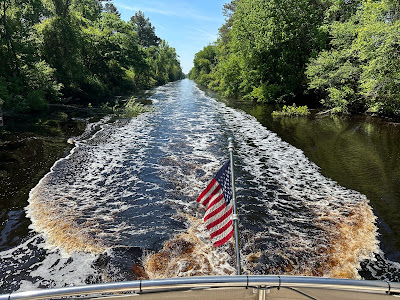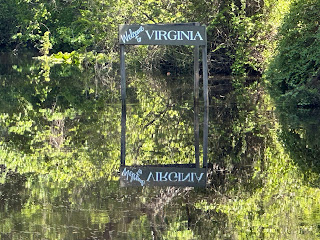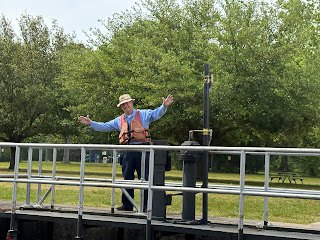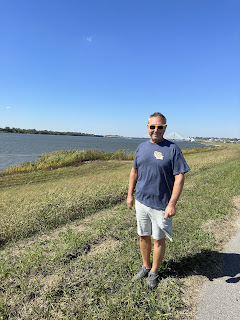Elizabeth City, Great Dismal Swamp & Norfolk (MM 79-0)...
April 26, 2023
Where we have been and where we are going...........
Elizabeth City is called the Harbor of Hospitality. In 1983, 2 boaters from here started bringing wine and cheese down to group of boaters tying up in town. One of those boaters also brought a rose to all of the women in the group. While these 2 men have passed on, the town people continue to meet boaters coming into the town to show their hospitality and welcome them into downtown Elizabeth City. There is a free marina in downtown but we chose to stay at Lamb's marina which is owned and run by Larry Lamb. One of the nicest gentlemen you would ever meet. He let us use his personal car to go downtown!
Indians inhabited this area for many years before English settlers came in 1587 to Roanoke Island. Throughout the state there are 8 recognized Indian tribes. Throughout both World War I and II, many Indians from the state volunteered to serve. Many times, the Indians talked in their native language to help send sensitive information to the Allies.
I learned in South Carolina that the start of the Carolina Colony was from King Charles II naming 8 Lord Proprietors for the land representing this colony. In 1729, 7 of them sold their land to King George II making North Carolina a royal colony. The area of Albemarle was the 8th person's property which was renamed the Granville Grant(there was more land than just this area). There was a boundary line made with Virginia which was called the "Dividing Line". The early years of this northeast part of North Carolina was also well known for providing hiding spots for pirates. Unfortunately, a hurricane closed the Roanoke Inlet in 1795 which substantially affected this area because of their lack of access to the Atlantic Ocean. This led to a more focused development of the Dismal Swamp Canal. The Dismal Swamp Canal connected the Pasquotank River to the Elizabeth River in Virginia and construction started in 1793 and opened to vessels in 1805. The town of Redding changed to Elizabeth City in 1801. During the War of 1812 when the British had ships blockading the entrance to North Carolina, materials were transferred up north and down south by way of the Great Dismal Swamp. The Dismal Swamp also became a location for escaped slaves to live or to escape north. During the Civil War, there was a Freedmen's Camp on Roanoke Island controlled by Union forces. This area was controlled through most of the Civil War by the Union troops after capturing Hatteras and Roanoke Island and closing off waterways in northeastern NC. There is history of some materials being transferred through the Dismal Swamp to Virginia to support Confederate troops. There was actually an ironclad built in this area called the CSS Albemarle during the Civil War.
The Museum of the Albemarle was a very good museum. On display, they had the Elizabeth City Tar Heel Newspaper from October 3, 1902 discussing the Wright brothers experiments with flight in the Outer Banks. The brothers would ride the train to Elizabeth City from Ohio and then take a boat to Kitty Hawk for there famous flight.
This area towards the coast during World War II was known as "Torpedo junction" due to German submarines traveling along the coast. The Navy maintained "blimps" in this area specifically Weeksville (just outside Elizabeth City). We saw a very large building where the blimps were stored in World War II. This building was a 1000 feet wide and 20 stories tall. The blimps were sent out to report on German U boat activity off the coast. They could stay up for 2 days without needing fuel. In 1957, the navy stopped using the facility. It is privately owned now.
Coast Guard has a base here that functions as the main search and rescue from New Jersey to Georgia. The museum on one of its boards said it was the biggest Coast Guard base in the continental United States of which I was unaware. There was also a special exhibit called High on the Hog about pork in the area. Eastern North Carolina BBQ is a vinegar based BBQ, not a red sauce.
 Early maps of the area showed not only the Great Dismal Swamp but also the Alligator Dismal Swamp.
Early maps of the area showed not only the Great Dismal Swamp but also the Alligator Dismal Swamp.
We stayed in Elizabeth City one night. They have 2 breweries there. They allow you to bring food into the brewery so we did that for dinner. The 2 breweries were Ghost Harbor Brewing and Seven Sounds Brewing. Danny liked them both. I thought the Seven Sounds had a neat display of their business.
The next morning with Larry Lamb seeing us off, we left at 6am with 2 other boats from Lamb's to catch the 8:30am lock. The lock is 300 feet by 50 feet so it can only carry so many boats. We were one of 6 boats so it was full.
In the Dismal Swamp, the water is very dark- tea colored from the tannins.
So before I tell you about our personal experience on The Great Dismal Swamp, let me tell you about the "swamp". Algonkin Indians were found in settlements around the swamp when Europeans explored the area. The Europeans found the area scary and threatening so the word worthless and dismal were often used to describe the area. In 1763, George Washington went to visit the Dismal Swamp and called it a "glorious paradise". Washington started the Dismal Swamp Canal Company. The Company used free, runaway, and enslaved black men to dig out the canal. Slaveholders would "rent" out their slaves in the area. Many of the runaways, who were called Maroons, would work with the supervisors who would look the other way. The first effort of the company was to build a canal to Lake Drummond to drain it for farming. It was unsuccessful. They turned their efforts to removing timber from the swamp and digging the swamp to connect North Carolina to Virginia. Interestingly, one of the boards in the visitors center stated every acre had been logged at least once. The Dismal Swamp is the oldest operating man made waterway in the United States totaling 22 miles. Initially, it was 1.28 million acres and is currently felt to be a third of the original size due to draining the swamp and removal of timber. Up until the development of railroads, the Dismal Swamp was considered a better alternative in moving cargo than using the treacherous Ocracoke Inlet. We saw a school group on a field trip as we passed the Visitor's Center where we tied up for a couple hours. As we left, Danny tooted his horn and the kids jumped up and down waving as we passed. Danny tooted again and they laughed.
Our travel on the Great Dismal Swamp has a story. I wanted to go this way on the Loop versus another option called the Virginia Cut. This route goes further east through a town called Coinjock, NC. Several years ago, Danny and I went through Coinjock when going to Manteo, NC in our Grady White boat. Danny wanted to go the Virginia Cut for one reason only- fear of hitting a fallen tree submerged under water. The Dismal Swamp is maintained at 6 feet of water through the locks. The Army Corp of Engineers goes through the swamp every spring to take out fallen trees and we saw a number marked on orange tape to be taken out. The hope is your boat carries less fuel and water not to weigh down the boat going through the swamp. We draw 3 feet 8 inches where our boat would hit bottom, so we should have no problem. We were in the middle of the channel about the middle of the pathway to the Virginia end of the swamp when there was a thump. We both said at the same time a four letter word starting with S and ending with T... The left engine was vibrating and we knew from the Tennessee River experience that was a sign our prop was bent most likely from hitting a submerged log. Neither of us saw anything. While continuing our travel we had secured a prop shop to fix it in Chesapeake and a diver the shop recommended to come take it off in Norfolk and bring to them. As we left the last lock, the boat in front of us was having difficulty gong forward, making the boat go backward towards us. Danny quickly put the boat in reverse to avoid a collision. When they went forward, Danny placed the boat in forward. The vibrating stopped! How do you explain that happening? The only thing Danny thought was a branch had hit the prop and wrapped around the prop and when he went into reverse, forced it off. Danny did different speeds, turning left and right and no more vibration. So now what should we do? Given we would be in Norfolk for a week, Danny wanted the props evaluated. When the diver arrived and pulled the prop off, there was a clump of dirt and mud with tangled roots. So likely, it was a branch of some type. The prop has a slight defect, it was fixed and both were balanced and all was good.
Our last lock for awhile was at Deep Creek in Virginia. You can see we went down. The lock system drops 8 feet, so this is the before and after as well as our lock master as we went out!
At rest and propless in Norfolk, Virginia at Waterside



















Comments
Post a Comment